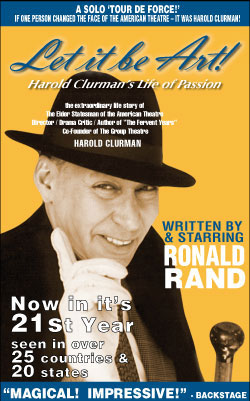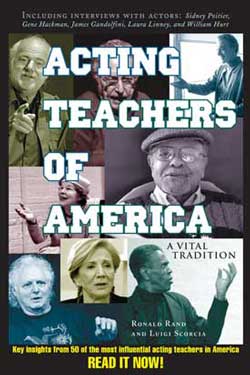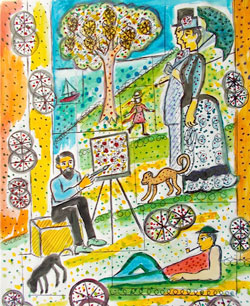Acting – an Act of Liberation.
Creating the Life of a Soul on Stage through
Stanislavsky’s “Method of Physical Actions” Technique
How does an actor create a human soul from a playwright’s words? What does it take to plumb the depths of writer’s work, and allow it to breathe through you for a few hours before an audience?
This mysterious act of intense communion and luminosity is achieved through the art of creation, which is ultimately how the stage artist defines himself. The sacred ritual of theatre is how the audience comes to know themselves.
Acting is an act of liberation. Of releasing spirit and senses to the moment. Of breathing together with the audience in a drop of time.
Rooted deep in the rich soil of our forebears, the art of acting teaches us how much there is to find out every time we go to the theatre – and for those on the stage, an opportunity to dig deeper until a singular ‘moment of recognition’ comes – a kernel of the truth of existence.
This is how the art of story-telling brings us closer to the ‘well of life.’ Every day the planet spins. Every day we face ourselves, take a breath and begin anew. The riddle of existence – always a mystery accompanying us. Our saving grace? That we can take a breath… and begin again. Return to our heart and trust our gut to ‘act human.’
The art of acting requires complete and total surrender. I accept this task every single time I step on the stage, whether it’s to bring Harold Clurman to life in my solo play or as another human being in the plays I’ve acted in.
When I enter on the stage I haven’t a clue whether Harold Clurman will say the “lines he’s supposed to say” that are in my script when he comes into ‘his apartment.’ But he doesn’t care. Why should he? He’s not in a play. He’s come to live ‘his life,’ to say what he has to say, do what he has to do.
So I must release myself completely to total transformation and surrender so he can live. I am in service to a force larger than myself. I accept the inevitable, allowing creation to occur.
The task of the artist of the stage is to open one’s heart, mind and soul to attain a purer way of seeing, of hearing, of listening, revealing all that we are through the act of remembering. Through the performer comes the deepest currents of nature, time and space, plunging us into the heart of consciousness.
It is incumbent for all those who dare to tread the thin line of revealing the deepest secrets of mankind through great literature to develop a mastery to share with others.
It remains just as important to build a confidence in “not knowing.”
The art of acting requires complete and total surrender to truth. So that somehow in the midst of knowing comes simply letting go – to wherever the moment will take you to discover the truth of the character’s behavior.
Breath, posture, weight, one’s relationship to the earth, every crease one feels in time is a revelation whether one is getting closer. The audience comes to be awakened to themselves, and just like the earth turning in motion beneath us, everything is always in constant motion, and we are faced with the ‘eternal questions.’
In order to allow a character to live his life in a play, the actor must release one’s self completely through the ‘Art of Transformation,’ using all parts of one’s heart and soul in service to true life on the stage.
Stanislavsky’s “Method of Physical Actions” allows this kind of surrender in service to a force of nature larger than one’s self. By accepting the inevitable, creation is allowed to occur.
Constantin Stanislavsky, the Co-founder of the famed Moscow Art Theatre and considered today to be the “Father of the Acting System,” spent the majority of his life working on this system in order to help organize and strengthen the creative process known as the art of acting.
His productions of Anton Chekhov’s “The Seagull,” The Cherry Orchard,” “Ivanov,” “The Three Sisters,” “Uncle Vanya,” and Maxim Gorky’s The Lower Depths” brought to the stage an intrinsic heartfelt way of exhibiting “true life” through the work of a great playwright.
It was towards the end of Stanislavsky’s life, after forty years of experimentation, that he created his “Method of Physical Actions” chart. Consisting of 40 acting tools, Stanislavsky laid out a path for the creative actor to take towards presenting truth on stage.
He described in great detail his theories in his autobiography, “My Life in Art” and his three books, “An Actor Prepares,” “Building a Character,” and “Creating a Role.” After his death, his complete works filled eight volumes, which were subsequently published.
Stanislavsky’s “System,” which he had worked on and formulated up to a certain point, was first taught in America by two Russian actors from the Moscow Art Theatre – Maria Ouspenskaya and Richard Bolaslavsky. They had stayed behind in America after a tour by the Moscow Art Theatre to New York City, and opened the American Laboratory Theatre. It was there that Stella Adler, Lee Strasberg and Harold Clurman, as well as many other young actors and teachers, studied the Stanislavsky System for the first time in the late 1920’s.
In 1930, The Group Theatre, founded by Harold Clurman, Lee Strasberg and Cheryl Crawford, was born and became the first acting ensemble in America to consciously use the Stanislavsky System as a way of working on new plays. Their work literally changed the face of acting and theater forever just like the Moscow Art Theatre had done before.
Out of The Group Theatre arose several different acting teachers who developed techniques based on Stanislavsky’s work, and several are still widely taught across America and around the world, including the Stella Adler technique, the Lee Strasberg Method, the Sandy Meisner technique, the Robert Lewis technique, Viola Spolin’s Improvisational work, and more recently, Anne Bogart’s Viewpoints. Other different ways of exploration were born from Bertolt Brecht’s work, Vakhtangov’s discoveries, as well as Jerzy Grotowski’s explorations, and were brought to the stage through the work of Joseph Chaikin and The Open Theatre, Judith Malina and Julian Beck and The Living Theatre, among many others.
The great Russian actor/teacher, Michael Chekhov, also came to America and England and taught his technique, which had a dramatic impact upon actors and acting up to today.
Stanislavsky’s “Method of Physical Actions” is a key into an actor’s creativity to capture the soul of another human being. Through a set of steps including “Working on one’s self,” “Action,” “Exhibiting feeling or passion through the resemblance of truth under given circumstances,” “Creating through a conscious technique which can arouse the subconscious,” and which all ultimately lead to “The creation of the life of a soul” on stage.
This way of working brings the actor forward as a creative artist, not only an interpreter of another’s work, but to be able to build the life of a character and then live in a most organic way, By freeing the human spirit of a character, the audience can witness a human being living on stage and not merely a caricature or an indication of a person, and truly dissolve into the story being told.
Other key elements of Stanislavsky’s “Method of Physical Actions” include: the “Magic IF,” “Given Circumstances,” “Concentration of Attention,” “Communion,” “Tempo-Rhythm,” “Imagination,” “Emotional Memory,” “Super-Objective,” “Physical Training,” and “Improvisation.”
Of course, these ideas had been put to discourse much earlier than Stanislavsky. In1832, the great writer, Goethe wrote: “The earlier man becomes aware that there exists a craft, an art that can help him towards a controlled heightening of his natural abilities, the happier he is…Here begins the manifold relationship between the conscious and the unconscious.”
That being said, essentially, we must also recognize that all sets of rules, tools or techniques of the craft of acting are always ‘a way in.’ One might say, a ‘stepping stone’ on the path towards a greater recognition or ‘inner-knowing’ leading towards the ultimate release of organic life on the stage. The soul of a character must be awakened into action, freed by what some refer to as ‘inspiration’ and live!
Around the year 1400, Zeami, who is known as the original practitioner of Japanese Noh theatre, wrote a classic book on dramatic theory called “Kadensho.” He led us to begin to see, by using the image of a flower as a metaphor, what performance could be seen as.
Kenneth Yasuda, through his book, “Masterworks of The Noh Theatre,” reminded us that: “A ‘flower’ is both an aesthetic principle, and like the soul of the actor or the character or the play, in itself it exists – but beyond that – there is the spiritual quest. Every element of the play, every gesture, must be devoted to the ‘flower.’
Perhaps when Zeami looked upon this ‘flower,’ he recognized how by shedding its petals, and going through many different stages till it disappears completely – that this process, makes the invisible visible. And just like an actor before an audience, who goes the art of transformation, may burst into life one moment before once more disappearing.
The sacred act of performance – to mirror nature through art – is really a universe we imagine we see. •2016
RONALD RAND Founder and Publisher of “The Soul of the American Actor,” now in its 17th year, it is the only wide-world Newspaper in print and online dedicated to the art of the theater, reaching over 25,000 readers. Author of the best-selling book, "Acting Teachers of America,” it is the most comprehensive book published on today’s most influential acting teachers in the United States. A Fulbright Teaching Specialist – hailed as a “Cultural Ambassador of America,” Mr. Rand brings to life Harold Clurman, considered “the most influential figure in the history of American theatre,” in his acclaimed solo play, “LET IT BE ART!” directed by Gregory Abels. In its 15th year, the play had two critically-acclaimed runs Off-Broadway, seen across 5 continents in 22 countries including London, Paris, Athens, Kathmandu, Mumbai, Bangkok, Buenos Aires, Harare, Belgrade, Tbilisi, Tangier, Paysundu, Barrancabermeja, New Delhi, Zagreb, Minsk, and in 17 states. Upcoming: Sarajevo, India, Italy, Florida and Pennsylvania. (www.LetItBeArt.com). This fall he will be teaching at the Academy of Drama Arts-University of Sarajevo; directing Murray Schisgal’s comedy, “LUV” at the Chamber Theatre 55 with a cast including Zana Marjanovic, Moamer Kasumovic and Muhamed Hadzovic; a Member of the Jury for the International Theatre MESS Festival & perform “LET IT BE ART!” in the OFF MESS. Mr. Rand holds the distinction of being the first American artist invited to Zimbabwe’s BAFA Festival of Arts, the first American invited to Russia’s “Voices of History” International Theatre Festival, and the first American to perform a play in the heart of Colombia at San Vicente’s Cultural Arts Center. (www.LetItBeArt.com) “LET IT BE ART!” also received acclaim at London’s Spiro Ark Theater, Paris’ Filmotheque Theatre, Colombia’s 2nd International Theatre Festival for Peace in Barrancabermeja, Cayman Islands’ Harquail Studio Theatre, Belgrade’s Slavija International Theatre Festival, Athens’ International Festival of Making Theatre, Buenos Aires’ Kafka Theatre, Tangier’s 17th century Sultan’s Palace Dar el-Makhzen at the International Intermediality Theatre Conference, Paysundu’s MerCoSur International Theatre Festival, Minsk’s Palace of Culture, Johannesburg’s Festival of Fame, Bangkok’s Patravadi Theatre, Kerala’s International Theatre Conference, Eskisehir State Theatre, Frankfurt’s Internationales Theater, Zagreb’s Academy of Dramatic Art, and across 17 states in America at New York University, Western Washington University, Syracuse University, University of Missouri-Columbia, Northern Illinois University, Freehold, Cornish School of the Arts and Gonzaga University. An Adjunct Professor of Acting at Pace University in New York City for four years, he has also been a guest professor at over 75 universities and colleges around the world. As a director, his productions as a director have been seen in New England and New York City, and include “Meltdown: Voices from Chernobyl,” “The Group!” and “Success Story.” In 2012, he co-translated and produced the U.S. premiere Off Broadway at La MaMa of the most famous play by Spain’s leading controversial playwright, Inigo Ramirez de Haro. Beginning his career as a child actor appearing in over 350 plays with a professional children’s theater in Florida, he made his Off-Broadway debut in Julius Caesar at BAM opposite Richard Dreyfuss, followed by numerous performances Off-Broadway, including “Servant of Two Masters’, “Ma Rainey’s Black Bottom,” “Endgame,” “Perfect Crime,” and toured across Europe as the Fool in King Lear. Mr. Rand has made over 200 film and television appearances including Emperor’s Club, In & Out, Family Business with Sean Connery, Rude Awakening as President Nixon, O’Keefe & Stieglitz opposite Christopher Plummer, Quiz Show directed by Robert Redford, and Homeless opposite Yoko Ono. As a playwright, his plays include THE GROUP! about The Group Theatre, and “IBSEN.” His productions as a director have been seen in New England and New York City, and include “Meltdown: Voices from Chernobyl,” “The Group!” and “Success Story.” In 2012, he co-translated and produced the U.S. premiere Off Broadway at La MaMa of the most famous play by Spain’s leading controversial playwright, Inigo Ramirez de Haro. Mr. Rand’s mentors include Stella Adler, Harold Clurman, Jerzy Grotowski, Joseph Chaikin, and Bobby Lewis.




























 by Ronald Rand
by Ronald Rand